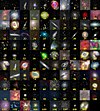NGC 6752
| Kugelsternhaufen NGC 6752 | |
|---|---|
 | |
| Aufnahme des MPG/ESO-2,2-m-Teleskops | |
| AladinLite | |
| Sternbild | Pfau |
| Position Äquinoktium: J2000.0, Epoche: J2000.0 | |
| Rektaszension | 19h 10m 51,8s [1] |
| Deklination | -59° 59′ 55″ [1] |
| Erscheinungsbild | |
| Konzentrationsklasse | VI [2] |
| Helligkeit (visuell) | 5,3 mag [2] |
| Winkelausdehnung | 29 [2] |
| Physikalische Daten | |
| Rotverschiebung | (−91 ± 9) · 10−6 [3] |
| Radialgeschwindigkeit | (−27,4 ± 2,7) km/s [3] |
| Entfernung | 13 kLj [4] |
| Masse | 160.000 M☉ |
| Durchmesser | 2,7 Lj |
| Alter | (13,8 ± 1,1) · 109 Jahre |
| Geschichte | |
| Entdeckung | James Dunlop |
| Entdeckungsdatum | 30. Juni 1826 |
| Katalogbezeichnungen | |
| NGC 6752 • C 1906-600 • GCl 108 • ESO 141-SC 30 • Dun 295 • GC 4467 • | |
NGC 6752 ist die Bezeichnung eines Kugelsternhaufens im Sternbild Pfau, dessen Entdeckung im Jahre 1826 von dem Astronomen James Dunlop im New General Catalogue verzeichnet ist.[5] NGC 6752 hat eine scheinbare Helligkeit von 5,3 mag und hat einen Winkeldurchmesser von 29'. Er ist somit nach 47 Tucanae und Omega Centauri der am hellsten erscheinende Kugelsternhaufen. Der Sternhaufen hat die 160.000-fache Masse der Sonne und einen Kerndurchmesser von 2,7 Lichtjahren;[6] sein Alter wird auf 13,8 Milliarden Jahre geschätzt, was dem Alter des Universums entspricht.[7]
Eine Untersuchung des Sternhaufens mit dem Hubble-Weltraumteleskop deutet darauf hin, dass 10–38 % der Sterne im Zentrum ein Doppelsternsystem bilden.[8] An NGC 6752 zeigte eine Untersuchung zur Sternentwicklung mittels Ultraviolettbeobachtungen, dass sich von den mehr als 100.000 Sternen 355 in einem Stadium befinden, in dem sie mehr als 30.000 Kelvin Oberflächentemperatur erreichen.[9][10]
Detailstudie des Zentrums des Hubble-Weltraumteleskops.
Aufnahme des Ultraviolet Imaging Telescope zur Untersuchung der Sternentwicklung in NGC 6752.
Weblinks
- Young stars at home in an ancient cluster (engl.)
- astronews.com: Bild des Tages 30. Januar 2012
Einzelnachweise
- ↑ NASA/IPAC EXTRAGALACTIC DATABASE
- ↑ a b c SEDS: NGC 6752
- ↑ SIMBAD Query
- ↑ NGC 6752
- ↑ Seligman
- ↑ A. Sollima u. a.: A comparison between the stellar and dynamical masses of six globular clusters. arxiv:1206.4828
- ↑ R. G. Gratton u. a.: Distances and ages of NGC6397, NGC6752 and 47 Tuc. arxiv:astro-ph/0307016
- ↑ Eric P. Rubenstein, Charles D. Bailyn: Hubble Space Telescope Observations of the Post--Core-Collapse Globular Cluster NGC 6752. II. A Large Main-Sequence Binary Population. bibcode:1997ApJ...474..701R
- ↑ Wayne B. Landsman u. a.: Ultraviolet Imagery of NGC 6752: A Test of Extreme Horizontal Branch Models. bibcode:1996ApJ...472L..93L, arxiv:astro-ph/9609127.
- ↑ S. Moehler, W. Landsman, R. Napiwotzki: Hot UV bright stars in globular clusters. bibcode:1998A&A...335..510M, arxiv:astro-ph/9803313.
Auf dieser Seite verwendete Medien
Autor/Urheber: ESA/Hubble & NASA, Lizenz: CC BY 3.0
Looking like a hoard of gems fit for an emperor’s collection, this deep sky object called NGC 6752 is in fact far more worthy of admiration. It is a globular cluster, and at over 10 billion years old is one the most ancient collections of stars known. It has been blazing for well over twice as long long as our Solar System has existed.
NGC 6752 contains a high number of “blue straggler” stars, some of which are visible in this image. These stars display characteristics of stars younger than their neighbours, despite models suggesting that most of the stars within globular clusters should have formed at approximately the same time. Their origin is therefore something of a mystery.
Studies of NGC 6752 may shed light on this situation. It appears that a very high number — up to 38% — of the stars within its core region are binary systems. Collisions between stars in this turbulent area could produce the blue stragglers that are so prevalent.
Lying 13 000 light-years distant, NGC 6752 is far beyond our reach, yet the clarity of Hubble’s images brings it tantalisingly close.Autor/Urheber: ESO, Lizenz: CC BY 4.0
This image from the Wide Field Imager on the MPG/ESO 2.2-metre telescope at the La Silla Observatory in Chile shows the globular star cluster NGC 6752 in the southern constellation of Pavo (The Peacock). Studies of this cluster using ESO’s Very Large Telescope have unexpectedly revealed that many of the stars do not undergo mass-loss at the end of their lives.
Astro-2 UIT Release Pictures: Ultraviolet Image of NGC6752 highlight Evolving Stars
Autor/Urheber: Roberto Mura, Lizenz: CC BY-SA 3.0
Caldwell Catalogue objects.






